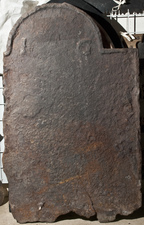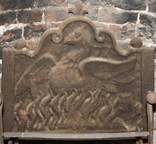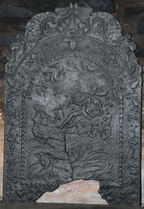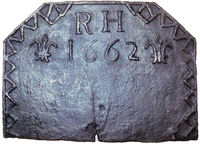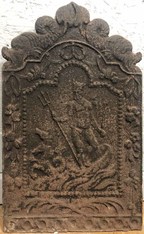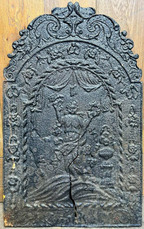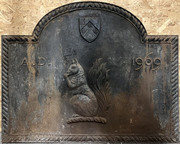-
1143
Description: Fragment, left side missing; arched rectangular shape; fillet edging (top and sides visible); initials IG widely spaced in arch.
Notes: Previously at Bream Court Farm, Newland, Gloucestershire.
Inscription: I G
- Decoration tags:
- rectangular with round arch (shape)
- fillet (edging)
- simple stamps
- individual letters
- text
Manufactured: in the 17th century possibly in the Forest of Dean area of England.
Current location: Dean Heritage Centre, Camp Mill, Soudley, Gloucestershire, England.
- Attached to series:
- Initials only firebacks
-
1079
Description: Quasi-arched rectangular shape; fillet edging, indented on the inner edge; pictorial representation of a phoenix rising from flames, date split either side of its neck; the lateral edges are wide in relation to the top, from which the arch rises from two loop and is surmounted by a fleur-de-lys; above each shoulder of the plate, a roundel.
Notes: The looped fillet edging is rarely seen and does not seem to be diagnostic of a particular pattern-maker.
Inscription: 16 77
- Decoration tags:
- rectangular with ornate arch (shape)
- fillet (edging)
- whole carved pattern
- pictorial
- mythological
- text
- animals
Manufactured: in 1677 possibly in the Staffordshire area of England.
Current location: Ford Green Hall, Ford Green Road, Smallthorne, Stoke-on-Trent, Staffordshire, England.
(part of the Stoke-on-Trent Museums museum group)
- Attached to series:
- Miscellaneous pattern firebacks
- Phoenix firebacks
- Loop edged firebacks
-
695
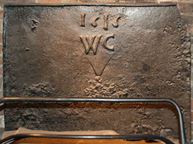 ? x ? mmImage subject to copyright
? x ? mmImage subject to copyrightDescription: Rectangular; fillet edging (top and sides only); top centre, date formed of individual letter stamps; below date, initials carved as single stamp, overstamped and showing v-shaped extension below.
Notes: The reason for the unusual shape of the base of the initial stamp is not understood.
Inscription: 1616 / WC
- Decoration tags:
- rectangular (shape)
- fillet (edging)
- carved stamps
- individual numbers
- text
Manufactured: in 1616 in England.
Current location: Nash's House, Stratford-upon-Avon, Warwickshire, England.
(part of the Shakespeare's Birthplace Trust museum group)
- Attached to series:
- Date & initials firebacks
-
696
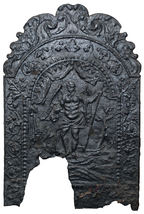 ? x ? mmImage subject to copyright
? x ? mmImage subject to copyrightDescription: Arched rectangular central panel with nutshell edging on a broad fillet; pictorial scene of a standing, winged male figure draped with a cloth, holding a staff in his left hand, above a ground, and with drapery over; arched rectangular border with fillet edging; alternating acanthus leaves with swirled tendrils; on top, two mirrored sea serpents.
Notes: Presumably intended to represent an angel; similarities in the design and execution of the pattern suggest the work of the pattern-maker identified as ‘N’ (q.v.); the missing segment had been filled with a piece from another fireback (removed in this photo).
Manufactured: in the early-18th century in England.
Current location: Nash's House, Stratford-upon-Avon, Warwickshire, England.
(part of the Shakespeare's Birthplace Trust museum group)
- Attached to series:
- British 'Dutch' style firebacks
- New Testament firebacks
-
698
Description: Arched rectangular central panel with nutshell edging on a broad fillet; pictorial scene of a figure in a chariot drawn by birds, above a ground, and with clouds over; arched rectangular border with fillet edging; alternating acanthus leaves with swirled tendrils; on top, two mirrored sea serpents.
Notes: Similarities in the design and execution of the pattern suggest the work of the pattern-maker identified as ‘N’.
- Decoration tags:
- 'Dutch' (shape)
- fillet (edging)
- whole carved pattern
- pictorial
- mythological
- animals
- humans
- objects
Manufactured: in the early-18th century in England.
Current location: Sulgrave Manor, Sulgrave, Northamptonshire, England.
- Attached to series:
- British 'Dutch' style firebacks
-
860
Description: Canted rectangle; fillet edging (top and sides); top centre, initials, above date, between repeated fleur-de-lys stamp; from top corners to bottom corners, repeated V-shape pattern formed of stamped short fillets, with an L-shape inserted between the top two Vs on each side.
Notes: The fleurs de lys are of a distinctive style seen on a small group of firebacks.
Inscription: RH / 1662
- Decoration tags:
- rectangular with canted top corners (shape)
- fillet (edging)
- simple stamps
- carved stamps
- individual letters
- individual numbers
- heraldic
- text
- objects
Manufactured: in 1662 in the Forest of Dean area of England.
Current location: not known.
- Attached to series:
- Date & initials firebacks
- Newent area group
-
1224
Description: Arched rectangular shaped central panel with canted, concave top corners and bead edging; naked, crowned figure of Neptune holding a trident in his right hand, standing amid waves and with two hippocampi to his right; same-shaped border with fillet edging and suspended ribbons with floral bunches; at base, symmetrical reeds tied with ribbon; base panel with nine linked rings; symmetrical serpents on top.
Notes: Other firebacks have the same distinctive central panel and border shape, suggesting the same pattern maker.
- Decoration tags:
- 'Dutch' (shape)
- fillet (edging)
- whole carved pattern
- pictorial
- mythological
- animals
- objects
Manufactured: in the early-18th century possibly in the Weald area of England.
Current location: not known.
- Attached to series:
- Mayfield 'Dutch' series
- British 'Dutch' style firebacks
-
1130
Description: Arched rectangular central panel with helical ribbon edging; pictorial image of a partially clothed female figure, holding an upraised wreath in her left hand and a garland in her right hand, standing on a ground, with a gadrooned vase containing flowers and leaves to the right and, above, swagged drapery; arched rectangular fillet border with descending leaves and flowers suspended from a wreath, top centre, and a wreath in each top corner; on top, mirrored swirled fronds terminating in the heads of sea monsters; bottom, vestiges of SHR monogram otherwise all decoration obliterated by fire damage.
Notes: The figure is an allegorical representation of Agriculture, one of the Iconologia originally published by Cesare Ripa in 1613.
Copies of this fireback are known.
Inscription: SHR
- Decoration tags:
- 'Dutch' (shape)
- fillet (edging)
- whole carved pattern
- allegorical
- text
- humans
- plants
- objects
Manufactured: in the early-18th century in England.
Current location: Authentic Reclamation, Lymden Lane, Ticehurst, East Sussex, England.
- Attached to series:
- Agriculture firebacks
- SHR series
- British 'Dutch' style firebacks
-
1257
Description: Arched rectangular shape, edged with simulated twisted rope between two fillets; in the arch, a shield: argent on a chevron gules three roses of the field, a canton gules for difference; beneath the shield a crest: on a wreath a squirrel sejant gules cracking a nut gules, charged on the shoulder with a cross crosslet gold for difference; inscription split either side of the head of the squirrel.
Notes: A finely modelled and cast modern fireback with the arms and crest of a direct descendant of John Davies Gilbert (1811-54) who had played a major role in the development of the town of Eastbourne and also developed Trelissick Garden in Feock, Cornwall.
Inscription: A.D. 1969
Arms: Gilbert, of Eastbourne, Sussex, and Trelissick, Cornwall
- Decoration tags:
- rectangular with round arch (shape)
- fillet (edging)
- whole carved pattern
- heraldic
- armorial
- text
- animals
Manufactured: in 1969 in England.
Current location: Authentic Reclamation, Lymden Lane, Ticehurst, East Sussex, England.
- Attached to series:
- Personal armorial firebacks
-
1297
Description: Arched rectangular shaped central panel with bead-on-fillet edging; a peacock, facing right, standing on a plinth, with foliage to the left and clouds above; arched rectangular shaped border with fillet edging, symmetrical floral fronds descending from a scallop shell, top centre, with a scallop shell inside each shoulder; at base, detail mostly obscured by corrosion but the numerals '17 24' are faintly visible in the bottom corners; on top, a pair of mirrored, stylised sea serpents with a central arrangement of foliage.
Notes: The image of the peacock may be an adaptation of an engraving (1654-62) by Wenceslaus Hollar, after Francis Barlow, in which a peacock also stands on a plinth. The small size of this fireback makes it likely that it was intended to be fixed to the back of a grate. A copy of a fireback of this design features in Gleanings from Old English Firesides by Arthur Todhunter.
Copies of this fireback are known.
Inscription: 17 24
- Decoration tags:
- 'Dutch' (shape)
- fillet (edging)
- whole carved pattern
- animals
Manufactured: in 1724 in England.
Current location: Authentic Reclamation, Lymden Lane, Ticehurst, East Sussex, England.
Citation: Todhunter, A., c.1910, Gleanings from Old English Firesides (New York, Arthur Todhunter), p. 3.
- Attached to series:
- British 'Dutch' style firebacks
- 1724 series
